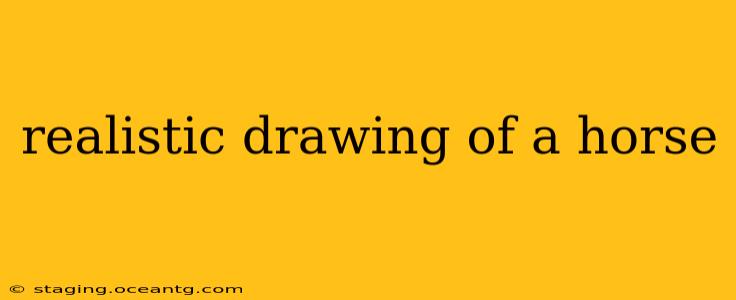Drawing a realistic horse requires patience, observation, and a keen understanding of equine anatomy. This guide will walk you through the process, covering everything from basic shapes to refined details. Whether you're a beginner or an experienced artist looking to improve your equine portraits, this comprehensive guide offers valuable insights and techniques.
What are the essential supplies for drawing a realistic horse?
Before you begin, gather your materials. Essential supplies for realistic horse drawing include:
- High-quality drawing paper: A smooth, heavy-weight paper (at least 90lb/190gsm) will minimize smudging and allow for layering.
- Pencils: A range of graphite pencils (e.g., H2, HB, 2B, 4B) for different levels of shading and detail. A kneaded eraser is invaluable for precise corrections.
- References: High-quality photographs of horses are essential. Choose images that clearly show the horse's anatomy from various angles.
- Sharpener: Keep your pencils consistently sharp for clean lines and details.
- Blending tools: Tortillons or cotton swabs can help smoothly blend tones for a more realistic look.
How do I start drawing a horse? Basic shapes and proportions.
Begin by breaking down the horse's complex form into simpler shapes. Think of the body as a series of interconnected ovals and cylinders:
- Overall Structure: Sketch a rough outline of the horse's body using simple shapes. This doesn't have to be perfect; it's a guideline.
- Head and Neck: Use ovals for the head and a slightly curved cylinder for the neck. Pay attention to the proportions – the head should be roughly one-third the length of the neck and body combined.
- Legs and Body: Use cylinders for the legs and a larger oval or rectangle for the body. Observe the angle of the legs and how they connect to the body.
- Tail: Sketch the tail as a flowing curve.
What are the key anatomical features to focus on when drawing a realistic horse?
Understanding equine anatomy is crucial for creating a believable portrayal. Pay close attention to:
- Musculature: Horses have powerful muscles, especially in the shoulders, legs, and hindquarters. Observe how these muscles bulge and flex according to the horse's posture.
- Bone Structure: The skeletal structure dictates the horse's overall form. While you won't necessarily draw the bones directly, understanding their location helps with accurate proportions and shading.
- Proportions: Pay attention to the ratios between different body parts. The head, neck, body, and legs should be accurately proportioned relative to each other.
How do I add details to my horse drawing?
Once the basic structure is established, gradually add details:
- Refinement of Shapes: Refine the initial shapes, making them more organic and fluid.
- Muscles and Bones: Gradually add muscle definition and subtle hints of bone structure.
- Mane and Tail: Add detail to the mane and tail, paying attention to the direction and flow of the hair.
- Facial Features: Carefully render the eyes, nostrils, and mouth.
- Hooves: Don't forget to carefully shape the hooves.
How do I add realistic shading and texture to my horse drawing?
Shading is crucial for creating depth and realism.
- Light Source: Identify your light source. This determines where the highlights and shadows fall.
- Value Scale: Use a range of pencil grades to create a gradual transition from light to dark. Begin with lighter pencils and progressively use darker ones for deeper shadows.
- Blending: Use blending tools to soften transitions between light and shadow.
- Texture: Vary your shading techniques to suggest the texture of the horse's coat, mane, and tail.
How can I improve my horse drawing skills?
Continuous practice and observation are key.
- Study Anatomy: Invest time in studying equine anatomy. Draw from life or high-quality references.
- Practice Regularly: The more you draw, the better you'll become.
- Seek Feedback: Show your work to other artists and get constructive criticism.
- Experiment with Different Media: Explore different drawing mediums to find what you enjoy and what suits your style.
By following these steps and practicing diligently, you can significantly improve your ability to create realistic horse drawings. Remember that patience and persistence are essential for mastering this art form.
